Liquid Story Binder and Me.
This is honestly something I’ve been meaning to do for ages, but I actually committed to doing it on the NaNo Forums earlier this week, so now I actually got around to doing it.
Anyone who’s talked to me on forums or anything about how I write and what I use, has likely heard me singing my praises for the program called Liquid Story Binder [link leads to the program’s tutorial page on their website]. Last year in early October, I was still fighting through the process of figuring out the timelines of all of the novels in my series, with hopes that I could finish Static Lightning Skies as part of my insane goal last year. So, I turned to the forums and jumped into the “timeline” thread that was there. Someone suggested LSB and I downloaded it, figuring there was nothing to lose with a 30-Day Free Trial. Hell, what was one more program installed and then deleted a week later... All in the name of fiction.
However, I quickly fell in love. After I went through the initial “omgwtfbbq?!” stage that I think everyone goes through when they first start using LSB. I spent hours looking online at screenshots and tutorials and poking at the sample book that comes with the program when you download it. I convinced a few writer friends to try the program with me, so we could be lost and figure it out together... And also lucked out by having a friend who had already been using the program for almost a month. Between us, we managed to get a pretty good grasp on the program and now I know that at least three of us swear by it for at least planning [I, for some reason, am still more comfortable doing most of my actual manuscript-style, start-to-finish writing in MS Word, personally].
So. With all of that said, behind the cut, you can find a ton of screen shots from multiple “books” in my LSB Library, showing you how I use LSB myself. In the comments, I encourage anyone reading this to post their own screenshots, showing different ways you use the program. Or heck, make a post in your own blog and put the link here? One of the best things about LSB is that there’s not just one way to use the many, many, many features that it has. I’m a nerd and love seeing how other people use the program. Hey, maybe you might even spark a use for something that no one has thought of before.
Please, share away!
You’re going to see shots from three different books [as defined by LSB; there’s actually like 20 novels within the three] in here, so if that random background changes are distracting, I apologize up front.
On the forums right now there’s a lot of discussion about Builders. Not gonna lie, this is the file type I originally never used because I couldn’t figure out how and I’ve only just recently gotten really comfortable using them. Part of this, I think is because I usually don’t write scene-by-scene, or even broken up into chapters. I tend to think of my novel as one whole piece -- which is why I think I still stick to Word to write. But, sometimes, things need to be broken up, and I think that’s the beauty of the Builder. It lets you take things apart, but at the same time, you can still look at it as a whole.
All images can be clicked to be made bigger / legible.
BUILDERS
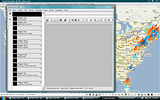
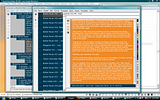
I use Builders in a lot of different ways. The first picture is of the first book in a series of four that I’m working on for a workshop that Keri and I are running this year, called The Big Yellow Board on WriYe. Because of the nature of the course, I’m ending up writing the book in little snippets and scenes. I wanted to make sure I knew exactly what had been written in the actual manuscript and where it went. This way I could see what needed to be done still... And it’s really easy to click from one segment to the next to make sure they match up well, even if they weren’t written together.
This all makes sense, but my problem comes in at the part that says "when all your chapters are finished." I mean, when is a chapter ever really finished? There's always editing to do, etc., and it seems that you'd have to "rebuild" the chapter every time you do a bit of editing.
-- inpariswithyou
This is true, definitely. Which is something that keeps me away from using Builders to actually write in... But, for this novel, I am using the Builder and writing in it, but I have yet to actually stitch the segments together. Most of the time [as you can see], I use the Builder for things that belong together, but don’t necessarily go together, if that makes any sense? I think that I’m going to hold off on actually building my Builder until I’ve already gone through the pieces that would be each chapter and edited them. Yeah, it’s true that you’re never really finished, but when I’m ready to call it done and put it away as a completed novel... That’s when it’ll get stitched. Before then, it would be a pain to remember to build it every time I moved a comma or changed any little thing.
The second Builder is of a piece that I wrote in sections for posting online and then did stitch together. At the very bottom, even, I added in the “Completed Text” that I built, just to remind me that it was there. Really, nothing new about that one... Just put it there to show contrast from the one above this.
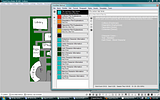
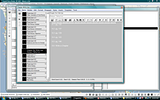
The first Builder is for a novel series that was actually my first NaNo attempt in 2004, but never made it off the ground. This year, I’ve been doing an online course called The Two Year Novel and have been reworking it -- actually getting things done -- but before, when I tried it the first time, I started out doing the Snowflake Method to plan before writing and have found the Builder to be a good place to put all of the pieces of that together. I think it’s a great example of what I meant by “things that belong together, but don’t necessarily go together.”
With this, I can glance at it and immediately tell a lot of things -- What the step is, what step number[s] are in each section, which book it belongs to, and if the character is one of the characters who I’m using to teach a lesson with [it’s a YA series] -- just by the titles and colored boxes on the side, which I love. Once I click on the one that I want, everything else is there. Plus, I have the first section that I use to hold all of my notes -- which is what you’re seeing in the screenshot -- so if I don’t work on the stuff for a while, I won’t forget what I was doing.
The second of these Builders is actually closely related to the first one in the previous section, except from the other end of things. This Builder shows the actual workshop, rather than my finished exercises from it. I’m the mod doing the even numbered chapters, and within each section, I have my summary of the section in the book that we’re discussing -- with my personal anecdotes and things added in -- plus the activity that goes along with it. At the beginning of each chapter, I list the sections, with the page numbers in the book for easy finding... And for the last one, there’s no activity, so I remind myself that it’s supposed to be adding another chapter to the manuscript so it’s not forgotten about.
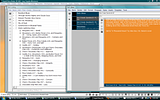
This last Builder is a completely different thing. This LSB book is for my 14-book series that I adore, which you can likely tell just by the fact that the colors are different, rather than the default gray-scheme that LSB has. RaTs is a prompt community that I used to be a fairly active member of, and I have all of my pieces that I wrote for the community in LSB. They span the entire series and were hell to put inside the program, but now that I have, it’s made my life so much easier. I can easily track which prompts I’ve used with the actual list of files [which you’ll see at the end of the entry], but with the Listing [file type in LSB] that I’ve made, I can also see which prompts have been written for which books and usually just by looking at the prompts, I know what the piece is.
But, that’s the Listing. The Builder in this case, I’m using for ideas -- that were also for RaTs -- in the titles, I have what type of idea it is [Ice Cream Sandwich = video / audio interpretation of the prompt] and which book it comes from so I know immediately which it is, so that when I’m ready to work on something, I can pick quickly from the [sadly unpopulated] list of ideas. And then in the actual text box, I have what I know about the idea / what I want to do with it.
DOSSIERS
Arguably, Dossiers are probably my second favorite feature of LSB. I love that they can keep everything about... Well, anything all in one place: information, pictures, maps, legit, anything you want to keep there, you can.

I like that you can easily edit and make up your own little “title” set to use for everything. Keeps everything consistent between characters and it autofills into the Dossier, so there’s no need to copy / paste, or [heaven forbid] retype everything. It’s just... Fast and easy. I love it. Mine is about half and half with my own creations and the ones that LSB comes with. The top two are for the workshops I have LSB books for, with each of the character sheets that the two different workshops used.
[yes, that is Nick Carter... yes, the character was rather inspired by him and thus shares his first name.. and has a brother named Aaron for lulz. yes, I am a BSB fangirl.]
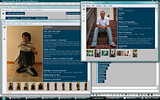
The one called “Characters” is a combination of the LSB default and my own creation. I thought some of the LSB titles were redundant and could be combined, plus I added in things that would clearly only be useful to me [eg -- which novel they belong to in the universe]. I use that for my Main Characters. #7 is for the minor characters in the same series. Numbers 5, 6, 9, and 0 are the ones that I haven’t had a use for and thus, haven’t touched...
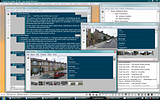
And #8, I have used, and to my recollection, I edited it slightly from the original set, but not a lot. I like these because it made me actually research the cities that I’m using in far more detail than I would have normally. I learned about the local government, costs of living, and a ton of other stuff that add to the details and level of realism when sprinkled in. It also allows me to add in pictures that I took of the places, plus street maps from Google, and more images that I found online to the Dossier, so whenever I’m writing, I can pull this up and bam. Everything there.
Let me ask: Is there a reason you prefer dossiers to builders? I'm not trying to argue whether your method or my method is "better" (In fact, I don't think that is even a possible comparison, let alone a useful one.) Rather, I'd like to see if there's a facet of the program I haven't noticed yet.
I've thought of developing dossiers for characters and locations, but it seems like there'd be a lot of wasted space; perhaps that's why, then, that I use builders instead. Perhaps you do more pre-writing to develop your characters and locations. I also don't like feeling trapped into the dossier headings, preferring the freedom of a builder to write whatever I want whenever I want however I want.
I do wish, however, that builders allowed for the insertion of other files. Images, in particular, since I have maps of my countries that I'd like to include. But nothing's perfect, I suppose...
-- inpariswithyou
You touch on one of the reasons I use Dossiers rather than Builders at the very end: the ability to add in pictures and maps. The second reason is because of the ability to link the individual Dossiers to a MindMap, which I like to use as a sort of twisted family tree that shows all of my characters in the way they relate to each other, plus all of the minor characters in the novel, listed with the novel they belong to for cross-referencing and... Yeah.
Perhaps the feeling trapped by the titles could be an issue resolved by making your own title lists? I know it took me ages before I realized I could do that [might have even been something that I was told by a friend, honestly] and once I figured that out [plus the addition of all the pretty pictures and the ability to link entire galleries to the Dossier], my love of the Dossier increased tenfold.
MINDMAPS
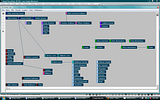
Since I mentioned it above, it makes sense that I showed my convoluted “family tree” next in this post. This is by and large my favorite thing about LSB. It... Makes my life so much easier than it was before, always “flipping through” the electronic pages of my novel, trying to remember what in the world the random barista / roommate / neighbor / etc. had been named earlier in the novel... And which novel it was that they were named in to begin with.
Now, I have this beautiful file.
I haven’t drawn in all the lines because, well, honestly, the line-drawing in LSB is more than a little frustrating, but as long as I line them up correctly, it’s pretty easy for me to tell how the characters are related. And, since it’s my novel, I generally know those things anyway.
Each book in the series has its own color in my head. So, that’s what the colors mean on the MindMap. The colors that are closely related [the blue /purples, the reds / pink] are novels that are pretty close together in the series / go together. The different shades of color show if they’re major characters or minor characters [bold / dark = main; light = minor].
This is still definitely a WIP, since I got LSB after already finishing the novel in the red, and most of the novel in lavender, but the blue in the bottom center was started and written after buying LSB, so it’s the most complete -- which you can probably tell just by looking at the amount of minor characters listed underneath.
I don’t have any shots of this, since the LSB Book for my HP fanfic is largely incomplete right now, but I also use MindMaps to keep all of the characters in both the original Harry Potter Series and my own Harry Potter fanfic straight. I have separate Maps for each year, in relation to my main character, labeled with how they relate to my MC [ie - year above = +1, two years below = -2] and each character is colored depending on their house, for easy identification.
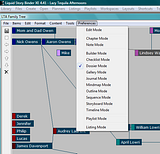
My favorite part about this file type? You can set the mode for each MindMap you’ve made. What this does, is when you double click on any of the entries in the Map, it will open the same-named-file of whatever you’ve linked it to [in this case, Dossiers]. And, if there isn’t a file for that name? It will prompt you to create one on the spot. It’s the same way that image galleries link automatically to the Dossier of the same name. Beautiful and so simple to keep everything organized and together.
OUTLINES AND LISTINGS
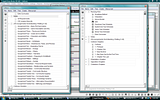
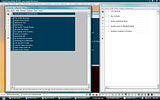
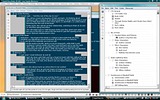
Somewhat related to that, I tend to list characters in my Listing. I have one for the entire series, because it’s easy to collapse and expand the sections that I need at the time. I liked to list the characters there as well as the MindMap because... Well, to be honest, I don’t really know. It just sort of seemed like the thing to do to keep everything easy to find, in another format.
Though, as you can tell, I haven’t kept that part of the Listing very updated because it seemed a little redundant. However, for the rest of the files, I love using Listings to keep everything up at the top together because sometimes my file titles aren’t the most helpful [eg - “Master”] and this way, I can see which novel they belong with pretty quickly.
I’m not sure why I grouped the Outline and the Listing together; I think likely just because they are what open up automatically when I open my Workspace, but yeah. There’s an Outline. I use them pretty much like I would if I were writing one by hand. This one is slightly different, because it was using RaTs prompts that were common British slang, so I listed the prompt, then the Americanized definition / explanation a British friend gave me below that, and then what would happen in the novel based on that prompt. Sometimes more detailed than others.
The first picture is just a fully expanded Listing for the YA series, showing all the assignments I’ve done as Notes.
TIMELINES
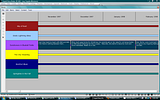
Feel free to laugh at how unfinished this Timeline is. Yes, a Timeline was the reason why I downloaded LSB in the first place... And as soon as I found out that the program would do just what I wanted it to, I immediately abandoned putting in the novels that had already been planned out. Yeah. Good job on that one, I know.
But, the NaNo from last year is all in there, and that’s what you’re seeing with text. But, it also shows how easily stackable the different aspects are. All of the text boxes are completely customizable, including the size of the boxes and the fonts within, plus the colors and... Yeah. You can expand the boxes to fit across more than one time box [like what I did with Dec/Jan], which is good.
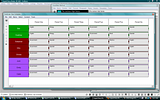
This is going back to the YA Series from before, showing another use of a Timeline -- a school schedule. The whole series takes place at Jackson High, so knowing where the characters are during the day and which of the Main Characters have what class together and when is super important.
Again, the different colors are for sorting purposes [depending on which clique they belong to in this example] and just makes for a nice and neat point of reference.
STORYBOARDS

This is actually something that I’m ridiculously proud of. Keeping all 14 books straight in regards to where they fit within time and how they’re connected and all is difficult to do by memory, so I opted to use a Storyboard to do it. Not gonna lie, Storyboards are one of the features in LSB that I thought immediately would be of no use to me, because I can’t draw anything [except dinosaurs]. So, finding a use for it makes me beyond proud.
I made little graphics for each book and then organized them chronologically. Each little panel lists the POV character, the timeframe of the novel, the title, and then sometimes a little note, depending on how much I’ve decided about the novel thus far. Something else I like about the Storyboard is that you can opt to turn the images off [though, then it’s little more than a horizontal Outline, really] and just use the boxes, if you’re not artistically inclined... Like me.
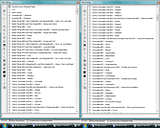







One of my concerns when first purchasing LSB was storage. I know friends who’d used what everyone claims is the Mac Version of LSB -- Scrivener -- and once they reached so many files, had issues loading their Workspace and lost data and such. But, I have yet to reach any sort of capacity issue with LSB, even with how many files [seen above] I have in my LTA Book. Let alone all four of the other books that I have in my LSB Library.
I store all of it on my 1GB flashdrive and haven’t found that it fills it much at all, plus, it comes with me everywhere. Even the program is on my flashdrive, so that no matter what computer I’m using, I can always access LSB and my information, which has been handier than I ever imagined it would be. So space should definitely not be a concern.
Obviously, there’s a LOT more about the program that I haven’t touched on here... But I’ve used the majority of the file types at least once at this point, or at least poked around at them, so feel free to ask questions, if you have them.
This program is my favorite writing software by far; I feel comfortable using it and even though I’m still learning new things about it every time I use it, I feel like I know my way around and what I’m doing. Again, I don’t profess to be a professional at using the program and know this is little more than just faffing about, showing people how I personally use the program most of the time... But that’s what I meant it to be. Not a tutorial.
In all honesty, I don’t know that there can every really be a tutorial for LSB because it’s a program that you can use in any way that you want to; there isn’t a set / definitive way to use the Builder, Timeline, Outline, etc. so who’s to tell you how you should use it, regardless of what works for you?
That said, if you want to know how I’ve done something that you see here, feel free to ask and I’ll be more than willing to help out. Or if you have questions that haven’t been answered about how to use something or how to do something that you want to do, feel free to leave a comment... If I’ve done it, I’ll help. Or even just suggest something to try and maybe get you going in the right direction. Or maybe someone else reading this post knows and they can help. And if there’s a File Type in LSB that isn’t shown here that you’d like to see, let me know. I can always share more screenshots. [:
Again, I encourage you guys to share your own shots and show the differences / similarities / just brag about your pretty workspaces. I love looking at other people’s screen shots just as much as I like sharing my own!
Thanks for reading!
--erin
Other Blog Posts About LSB:
Psychic Toaster’s Posts / Downloads
inpariswithyou's Post / Screenshots [friendlystars on DW]
Anyone who’s talked to me on forums or anything about how I write and what I use, has likely heard me singing my praises for the program called Liquid Story Binder [link leads to the program’s tutorial page on their website]. Last year in early October, I was still fighting through the process of figuring out the timelines of all of the novels in my series, with hopes that I could finish Static Lightning Skies as part of my insane goal last year. So, I turned to the forums and jumped into the “timeline” thread that was there. Someone suggested LSB and I downloaded it, figuring there was nothing to lose with a 30-Day Free Trial. Hell, what was one more program installed and then deleted a week later... All in the name of fiction.
However, I quickly fell in love. After I went through the initial “omgwtfbbq?!” stage that I think everyone goes through when they first start using LSB. I spent hours looking online at screenshots and tutorials and poking at the sample book that comes with the program when you download it. I convinced a few writer friends to try the program with me, so we could be lost and figure it out together... And also lucked out by having a friend who had already been using the program for almost a month. Between us, we managed to get a pretty good grasp on the program and now I know that at least three of us swear by it for at least planning [I, for some reason, am still more comfortable doing most of my actual manuscript-style, start-to-finish writing in MS Word, personally].
So. With all of that said, behind the cut, you can find a ton of screen shots from multiple “books” in my LSB Library, showing you how I use LSB myself. In the comments, I encourage anyone reading this to post their own screenshots, showing different ways you use the program. Or heck, make a post in your own blog and put the link here? One of the best things about LSB is that there’s not just one way to use the many, many, many features that it has. I’m a nerd and love seeing how other people use the program. Hey, maybe you might even spark a use for something that no one has thought of before.
Please, share away!
You’re going to see shots from three different books [as defined by LSB; there’s actually like 20 novels within the three] in here, so if that random background changes are distracting, I apologize up front.
On the forums right now there’s a lot of discussion about Builders. Not gonna lie, this is the file type I originally never used because I couldn’t figure out how and I’ve only just recently gotten really comfortable using them. Part of this, I think is because I usually don’t write scene-by-scene, or even broken up into chapters. I tend to think of my novel as one whole piece -- which is why I think I still stick to Word to write. But, sometimes, things need to be broken up, and I think that’s the beauty of the Builder. It lets you take things apart, but at the same time, you can still look at it as a whole.
All images can be clicked to be made bigger / legible.
BUILDERS


I use Builders in a lot of different ways. The first picture is of the first book in a series of four that I’m working on for a workshop that Keri and I are running this year, called The Big Yellow Board on WriYe. Because of the nature of the course, I’m ending up writing the book in little snippets and scenes. I wanted to make sure I knew exactly what had been written in the actual manuscript and where it went. This way I could see what needed to be done still... And it’s really easy to click from one segment to the next to make sure they match up well, even if they weren’t written together.
This all makes sense, but my problem comes in at the part that says "when all your chapters are finished." I mean, when is a chapter ever really finished? There's always editing to do, etc., and it seems that you'd have to "rebuild" the chapter every time you do a bit of editing.
-- inpariswithyou
This is true, definitely. Which is something that keeps me away from using Builders to actually write in... But, for this novel, I am using the Builder and writing in it, but I have yet to actually stitch the segments together. Most of the time [as you can see], I use the Builder for things that belong together, but don’t necessarily go together, if that makes any sense? I think that I’m going to hold off on actually building my Builder until I’ve already gone through the pieces that would be each chapter and edited them. Yeah, it’s true that you’re never really finished, but when I’m ready to call it done and put it away as a completed novel... That’s when it’ll get stitched. Before then, it would be a pain to remember to build it every time I moved a comma or changed any little thing.
The second Builder is of a piece that I wrote in sections for posting online and then did stitch together. At the very bottom, even, I added in the “Completed Text” that I built, just to remind me that it was there. Really, nothing new about that one... Just put it there to show contrast from the one above this.


The first Builder is for a novel series that was actually my first NaNo attempt in 2004, but never made it off the ground. This year, I’ve been doing an online course called The Two Year Novel and have been reworking it -- actually getting things done -- but before, when I tried it the first time, I started out doing the Snowflake Method to plan before writing and have found the Builder to be a good place to put all of the pieces of that together. I think it’s a great example of what I meant by “things that belong together, but don’t necessarily go together.”
With this, I can glance at it and immediately tell a lot of things -- What the step is, what step number[s] are in each section, which book it belongs to, and if the character is one of the characters who I’m using to teach a lesson with [it’s a YA series] -- just by the titles and colored boxes on the side, which I love. Once I click on the one that I want, everything else is there. Plus, I have the first section that I use to hold all of my notes -- which is what you’re seeing in the screenshot -- so if I don’t work on the stuff for a while, I won’t forget what I was doing.
The second of these Builders is actually closely related to the first one in the previous section, except from the other end of things. This Builder shows the actual workshop, rather than my finished exercises from it. I’m the mod doing the even numbered chapters, and within each section, I have my summary of the section in the book that we’re discussing -- with my personal anecdotes and things added in -- plus the activity that goes along with it. At the beginning of each chapter, I list the sections, with the page numbers in the book for easy finding... And for the last one, there’s no activity, so I remind myself that it’s supposed to be adding another chapter to the manuscript so it’s not forgotten about.

This last Builder is a completely different thing. This LSB book is for my 14-book series that I adore, which you can likely tell just by the fact that the colors are different, rather than the default gray-scheme that LSB has. RaTs is a prompt community that I used to be a fairly active member of, and I have all of my pieces that I wrote for the community in LSB. They span the entire series and were hell to put inside the program, but now that I have, it’s made my life so much easier. I can easily track which prompts I’ve used with the actual list of files [which you’ll see at the end of the entry], but with the Listing [file type in LSB] that I’ve made, I can also see which prompts have been written for which books and usually just by looking at the prompts, I know what the piece is.
But, that’s the Listing. The Builder in this case, I’m using for ideas -- that were also for RaTs -- in the titles, I have what type of idea it is [Ice Cream Sandwich = video / audio interpretation of the prompt] and which book it comes from so I know immediately which it is, so that when I’m ready to work on something, I can pick quickly from the [sadly unpopulated] list of ideas. And then in the actual text box, I have what I know about the idea / what I want to do with it.
DOSSIERS
Arguably, Dossiers are probably my second favorite feature of LSB. I love that they can keep everything about... Well, anything all in one place: information, pictures, maps, legit, anything you want to keep there, you can.

I like that you can easily edit and make up your own little “title” set to use for everything. Keeps everything consistent between characters and it autofills into the Dossier, so there’s no need to copy / paste, or [heaven forbid] retype everything. It’s just... Fast and easy. I love it. Mine is about half and half with my own creations and the ones that LSB comes with. The top two are for the workshops I have LSB books for, with each of the character sheets that the two different workshops used.
[yes, that is Nick Carter... yes, the character was rather inspired by him and thus shares his first name.. and has a brother named Aaron for lulz. yes, I am a BSB fangirl.]

The one called “Characters” is a combination of the LSB default and my own creation. I thought some of the LSB titles were redundant and could be combined, plus I added in things that would clearly only be useful to me [eg -- which novel they belong to in the universe]. I use that for my Main Characters. #7 is for the minor characters in the same series. Numbers 5, 6, 9, and 0 are the ones that I haven’t had a use for and thus, haven’t touched...

And #8, I have used, and to my recollection, I edited it slightly from the original set, but not a lot. I like these because it made me actually research the cities that I’m using in far more detail than I would have normally. I learned about the local government, costs of living, and a ton of other stuff that add to the details and level of realism when sprinkled in. It also allows me to add in pictures that I took of the places, plus street maps from Google, and more images that I found online to the Dossier, so whenever I’m writing, I can pull this up and bam. Everything there.
Let me ask: Is there a reason you prefer dossiers to builders? I'm not trying to argue whether your method or my method is "better" (In fact, I don't think that is even a possible comparison, let alone a useful one.) Rather, I'd like to see if there's a facet of the program I haven't noticed yet.
I've thought of developing dossiers for characters and locations, but it seems like there'd be a lot of wasted space; perhaps that's why, then, that I use builders instead. Perhaps you do more pre-writing to develop your characters and locations. I also don't like feeling trapped into the dossier headings, preferring the freedom of a builder to write whatever I want whenever I want however I want.
I do wish, however, that builders allowed for the insertion of other files. Images, in particular, since I have maps of my countries that I'd like to include. But nothing's perfect, I suppose...
-- inpariswithyou
You touch on one of the reasons I use Dossiers rather than Builders at the very end: the ability to add in pictures and maps. The second reason is because of the ability to link the individual Dossiers to a MindMap, which I like to use as a sort of twisted family tree that shows all of my characters in the way they relate to each other, plus all of the minor characters in the novel, listed with the novel they belong to for cross-referencing and... Yeah.
Perhaps the feeling trapped by the titles could be an issue resolved by making your own title lists? I know it took me ages before I realized I could do that [might have even been something that I was told by a friend, honestly] and once I figured that out [plus the addition of all the pretty pictures and the ability to link entire galleries to the Dossier], my love of the Dossier increased tenfold.
MINDMAPS

Since I mentioned it above, it makes sense that I showed my convoluted “family tree” next in this post. This is by and large my favorite thing about LSB. It... Makes my life so much easier than it was before, always “flipping through” the electronic pages of my novel, trying to remember what in the world the random barista / roommate / neighbor / etc. had been named earlier in the novel... And which novel it was that they were named in to begin with.
Now, I have this beautiful file.
I haven’t drawn in all the lines because, well, honestly, the line-drawing in LSB is more than a little frustrating, but as long as I line them up correctly, it’s pretty easy for me to tell how the characters are related. And, since it’s my novel, I generally know those things anyway.
Each book in the series has its own color in my head. So, that’s what the colors mean on the MindMap. The colors that are closely related [the blue /purples, the reds / pink] are novels that are pretty close together in the series / go together. The different shades of color show if they’re major characters or minor characters [bold / dark = main; light = minor].
This is still definitely a WIP, since I got LSB after already finishing the novel in the red, and most of the novel in lavender, but the blue in the bottom center was started and written after buying LSB, so it’s the most complete -- which you can probably tell just by looking at the amount of minor characters listed underneath.
I don’t have any shots of this, since the LSB Book for my HP fanfic is largely incomplete right now, but I also use MindMaps to keep all of the characters in both the original Harry Potter Series and my own Harry Potter fanfic straight. I have separate Maps for each year, in relation to my main character, labeled with how they relate to my MC [ie - year above = +1, two years below = -2] and each character is colored depending on their house, for easy identification.

My favorite part about this file type? You can set the mode for each MindMap you’ve made. What this does, is when you double click on any of the entries in the Map, it will open the same-named-file of whatever you’ve linked it to [in this case, Dossiers]. And, if there isn’t a file for that name? It will prompt you to create one on the spot. It’s the same way that image galleries link automatically to the Dossier of the same name. Beautiful and so simple to keep everything organized and together.
OUTLINES AND LISTINGS



Somewhat related to that, I tend to list characters in my Listing. I have one for the entire series, because it’s easy to collapse and expand the sections that I need at the time. I liked to list the characters there as well as the MindMap because... Well, to be honest, I don’t really know. It just sort of seemed like the thing to do to keep everything easy to find, in another format.
Though, as you can tell, I haven’t kept that part of the Listing very updated because it seemed a little redundant. However, for the rest of the files, I love using Listings to keep everything up at the top together because sometimes my file titles aren’t the most helpful [eg - “Master”] and this way, I can see which novel they belong with pretty quickly.
I’m not sure why I grouped the Outline and the Listing together; I think likely just because they are what open up automatically when I open my Workspace, but yeah. There’s an Outline. I use them pretty much like I would if I were writing one by hand. This one is slightly different, because it was using RaTs prompts that were common British slang, so I listed the prompt, then the Americanized definition / explanation a British friend gave me below that, and then what would happen in the novel based on that prompt. Sometimes more detailed than others.
The first picture is just a fully expanded Listing for the YA series, showing all the assignments I’ve done as Notes.
TIMELINES

Feel free to laugh at how unfinished this Timeline is. Yes, a Timeline was the reason why I downloaded LSB in the first place... And as soon as I found out that the program would do just what I wanted it to, I immediately abandoned putting in the novels that had already been planned out. Yeah. Good job on that one, I know.
But, the NaNo from last year is all in there, and that’s what you’re seeing with text. But, it also shows how easily stackable the different aspects are. All of the text boxes are completely customizable, including the size of the boxes and the fonts within, plus the colors and... Yeah. You can expand the boxes to fit across more than one time box [like what I did with Dec/Jan], which is good.

This is going back to the YA Series from before, showing another use of a Timeline -- a school schedule. The whole series takes place at Jackson High, so knowing where the characters are during the day and which of the Main Characters have what class together and when is super important.
Again, the different colors are for sorting purposes [depending on which clique they belong to in this example] and just makes for a nice and neat point of reference.
STORYBOARDS

This is actually something that I’m ridiculously proud of. Keeping all 14 books straight in regards to where they fit within time and how they’re connected and all is difficult to do by memory, so I opted to use a Storyboard to do it. Not gonna lie, Storyboards are one of the features in LSB that I thought immediately would be of no use to me, because I can’t draw anything [except dinosaurs]. So, finding a use for it makes me beyond proud.
I made little graphics for each book and then organized them chronologically. Each little panel lists the POV character, the timeframe of the novel, the title, and then sometimes a little note, depending on how much I’ve decided about the novel thus far. Something else I like about the Storyboard is that you can opt to turn the images off [though, then it’s little more than a horizontal Outline, really] and just use the boxes, if you’re not artistically inclined... Like me.








One of my concerns when first purchasing LSB was storage. I know friends who’d used what everyone claims is the Mac Version of LSB -- Scrivener -- and once they reached so many files, had issues loading their Workspace and lost data and such. But, I have yet to reach any sort of capacity issue with LSB, even with how many files [seen above] I have in my LTA Book. Let alone all four of the other books that I have in my LSB Library.
I store all of it on my 1GB flashdrive and haven’t found that it fills it much at all, plus, it comes with me everywhere. Even the program is on my flashdrive, so that no matter what computer I’m using, I can always access LSB and my information, which has been handier than I ever imagined it would be. So space should definitely not be a concern.
Obviously, there’s a LOT more about the program that I haven’t touched on here... But I’ve used the majority of the file types at least once at this point, or at least poked around at them, so feel free to ask questions, if you have them.
This program is my favorite writing software by far; I feel comfortable using it and even though I’m still learning new things about it every time I use it, I feel like I know my way around and what I’m doing. Again, I don’t profess to be a professional at using the program and know this is little more than just faffing about, showing people how I personally use the program most of the time... But that’s what I meant it to be. Not a tutorial.
In all honesty, I don’t know that there can every really be a tutorial for LSB because it’s a program that you can use in any way that you want to; there isn’t a set / definitive way to use the Builder, Timeline, Outline, etc. so who’s to tell you how you should use it, regardless of what works for you?
That said, if you want to know how I’ve done something that you see here, feel free to ask and I’ll be more than willing to help out. Or if you have questions that haven’t been answered about how to use something or how to do something that you want to do, feel free to leave a comment... If I’ve done it, I’ll help. Or even just suggest something to try and maybe get you going in the right direction. Or maybe someone else reading this post knows and they can help. And if there’s a File Type in LSB that isn’t shown here that you’d like to see, let me know. I can always share more screenshots. [:
Again, I encourage you guys to share your own shots and show the differences / similarities / just brag about your pretty workspaces. I love looking at other people’s screen shots just as much as I like sharing my own!
Thanks for reading!
--erin
Other Blog Posts About LSB:
Psychic Toaster’s Posts / Downloads
inpariswithyou's Post / Screenshots [friendlystars on DW]